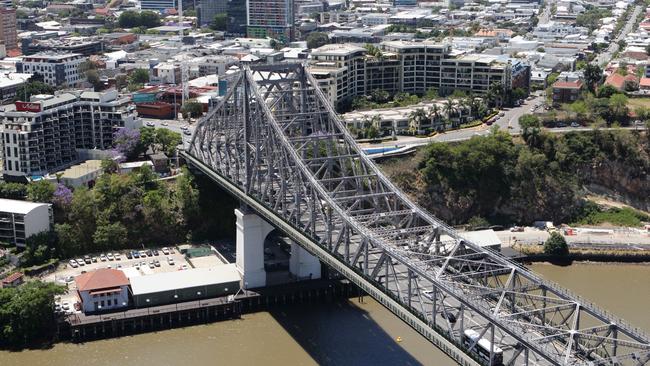Mike O’Connor: Flags on a bridge won’t change anything
Common sense scored a rare victory over tokenism and virtue signalling when it was suggested two new flags be flown atop the Story Bridge, writes Mike O’Connor.
Mike O'Connor
Don't miss out on the headlines from Mike O'Connor. Followed categories will be added to My News.
Common sense scored a rare victory over tokenism and virtue signalling last week and we have Brisbane’s Lord Mayor Adrian Schrinner to thank for it.
At issue was a move by the Labor councillor for Morningside Kara
Cook to have two new flags flown atop the Story Bridge, joining the Australian and Queensland flags presently in place.
No discount on your rates notice for guessing that the flags in question were the Aboriginal flag and the Torres Strait Islander flag, with Ms Cook demanding Mr Schrinner “show leadership on this”.
“Reconciliation is something that should be a priority for our city, and this is one way we can stand with our First Nations communities,” she said.
Mr Schrinner replied that it would cost millions of dollars to install two new flagpoles and that the money could be better spent elsewhere.

Mick Gooda, co-chair of the Queensland Treaty Advancement Committee, was quick to offer a solution, saying the Brisbane City Council could take down one of the existing flags and replace it with an Aboriginal one, a move which would be part of what he called a “path to Treaty and truth telling in Brisbane”.
Here’s another truth, inconvenient though it might be.
The Australian flag represents all Australians and the Queensland flag all Queenslanders regardless of their race, so why should either of them be removed in order to fly a flag which represents one particular racial group?
Commissioner for the Queensland Family and Child Commission and Gamilaraay Yinnar woman Natalie Lewis also weighed into the debate, saying if new flagpoles were to be installed, she wanted Indigenous businesses included in any works.
So the normal tendering process designed to give everyone a fair go and ensure the council got value for money would be cast aside and Indigenous businesses given preferential treatment, exclusion masquerading as inclusion.
Mr Schrinner is to be congratulated for having the courage to suffer the wrath of the Twitterati and for refusing to spend ratepayers’ money pandering to virtue signallers.
What a simple thing it is to demand the flying of a flag representing 3 per cent of the population and tell yourself how inclusive and “woke” you are.
Like Ms Cook, I’m all for truth telling and would urge all those of a similar ilk to acquaint themselves with an address delivered recently by Northern Territory Supreme Court Judge Justice Judith Kelly in which she said in part: “Everyone is willing to talk about the over-representation of Aboriginal men in prison. It has been called Australia’s shame and so it is. But, as I have said before, the stream of Aboriginal men going to prison is matched by a steady stream – a river – of Aboriginal women going to the hospital and to the morgue. It is an epidemic of extreme domestic violence.
“Between 2000 and 2022, two Aboriginal men were shot by police, both times followed by massive press coverage, calls for inquiries and so on.
“In that same period, 65 Aboriginal women were killed by their partners and in each case you would have been flat out seeing a small report on page 5 or 7 of a local newspaper – nothing nationally,” she said.
“Indigenous women are approximately 10 times more likely to be the victim of an assault than
non-Indigenous women, and 32 times more likely to end up in hospital than a non-Indigenous woman victim. What can we as lawyers – and the courts – do about it? Pretty much nothing.
“We judges keep making the same sentencing remarks – talking about the prevalence of domestic violence, emphasising general deterrence, personal deterrence for repeat offenders, denunciation, community protection and so on – for all the good it does anyone.
“We imprison the offenders. Judging by the recidivism rate, that doesn’t do anyone much good either.
“Talking honestly about the problems that exist and encouraging honest and open public debate would have to be a good start,” she said.
We talk a big game on eradicating domestic violence but when it occurs in a particular section of the community, we look the other way and dare not speak its name.



